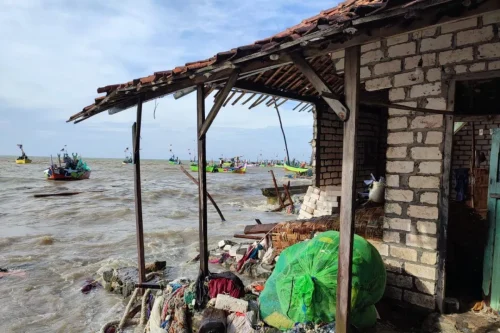The Urgency of Coastal Management in the North Coast of Java (Pantura), Indonesia

Photo Credit : Wetlands International Indonesia
The North Coast of Java, often referred to as Pantura, is a coastal region located along the north coast of the island of Java, Indonesia. This region has its own importance in the context of ecology, economy, and socio-culture. However, Pantura also faces various issues that require serious management. In this article, we will discuss the urgency of coastal management in Pantura Indonesia and the issues that need to be addressed.
- Beach Abrasion and Soil Erosion
One of the main issues faced by the Pantura coastal region is beach abrasion and soil erosion. Abrasion and soil erosion are two phenomena that often occur in coastal areas including Pantura. Beach abrasion occurs when waves and sea currents erode the coastline, while soil erosion generally affects rocks and soil in various regions. Human activities such as sand mining, unplanned construction, and unsustainable land use have caused changes in the coastline and damage to coastal ecosystems. Abrasion and soil erosion threaten coastal infrastructure, settlements, and surrounding agricultural land. Good and sustainable management is needed to mitigate further damage and protect coastal areas from these threats.
For example, in Central Java, the extraction of groundwater is considered very severe. Because the soil of Pantura is mostly clay soil resulting from accretion and sedimentation, so it is not yet stable in geological age. Since 2013, the north coast of Central Java has been affected by abrasion covering 7,957.89 hectares that erodes various people’s lands in 17 regencies/cities (IDN Times).

Photo Credit : Arie Basuki/Tempo
- Sea Pollution and Waste
Pantura also faces the problem of sea pollution and waste. Industrial, agricultural, and irregular settlement activities often produce waste that pollutes coastal waters. This pollution can damage marine ecosystems, threaten marine life, and negatively impact the fisheries and tourism sectors. It is important to implement an effective waste management system, including proper waste treatment and strict supervision of polluting sources.
Lamongan in East Java faces serious problems related to sea pollution and waste caused by microplastic concentrations. 9 points of waste accumulation area were found ranging from small ones about 1-2 meters to more than 5 meters. This condition is exacerbated by the poor waste management system (Tribunnews, 2020).
- Climate Change and Sea Level Rise
Climate change, including global warming and sea level rise, is a serious threat to the coastal environment, especially in the Pantura. Sea level rise can cause seawater intrusion into coastal areas, affecting groundwater quality, and damaging coastal ecosystems such as mangrove forests. In addition, climate change can also cause extreme weather events such as floods and storms, which can have negative impacts on infrastructure and local communities.
Coastal management must take into account the impacts of climate change and implement the necessary adaptation measures. The pantura area that is clearly affected by climate change is Tambak Raya Beach and Karangsong Beach in Indramayu Regency, West Java. Abrasion and big waves caused some places that were originally built on the beach, now filled with seawater. The damage to the coastal infrastructure shows the change in natural morphology that was not anticipated properly. The impact of climate change, shown by the rise in sea level, continued to abrasion, accretion [emerging land], and tidal flooding, has destroyed the tourist facilities that have been made. (Mongabay, 2020).

Photo Credit : HO-BNPB/ANTARA
- Land Ownership Conflict and Unsustainable Land Use
Pantura also faces the problem of land ownership conflict and unsustainable land use. Population growth and rapid infrastructure development often result in the conversion of coastal land into settlements, industries, or intensive agricultural sectors.
Land ownership conflicts between indigenous communities, government, and private sector often occur. It is important to develop clear policies on coastal land use, as well as involve the community in the decision-making process to minimize conflict and ensure sustainable land use.
- Biodiversity Loss and Ecosystem Damage
Unsustainable land use and uncontrolled human activities have caused biodiversity loss and ecosystem damage in Pantura. Mangrove forests, which are important for coastal protection and marine life, have experienced significant deforestation. Coral reefs are also threatened by pollution and human activities that damage them. It is important to maintain the sustainability and restore the damaged coastal ecosystems through sustainable management, including protecting the remaining mangrove forests and implementing environmentally friendly agricultural and industrial practices.
To address the urgency of coastal management in Pantura Indonesia, an integrated effort from the government, community, and private sector is needed. Some steps that can be taken include:
- Development of sustainable policies and planning for coastal land use.
- Strict supervision of sand mining activities, illegal construction, and industrial pollution.
- Increasing community awareness of the importance of coastal management through education campaigns and active community participation in decision making.
- Increasing the capacity of local communities in coastal resource management through training and education.
- Implementation of an effective waste management system and environmentally friendly technology.
- Collaboration between government, community, and private sector in developing sustainable projects, including coastal ecosystem restoration and ecotourism development.
With good and sustainable coastal management in Pantura Indonesia, it is expected that the sustainability of coastal ecosystems, biodiversity recovery, and economic and socio-cultural sustainability of coastal communities can be achieved. In addition, these measures will also help maintain the resilience of coastal areas to climate change and other threats.

